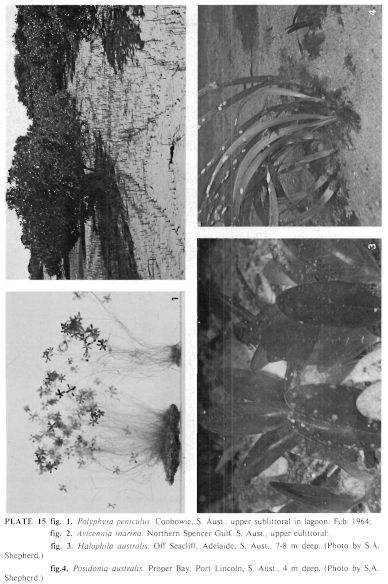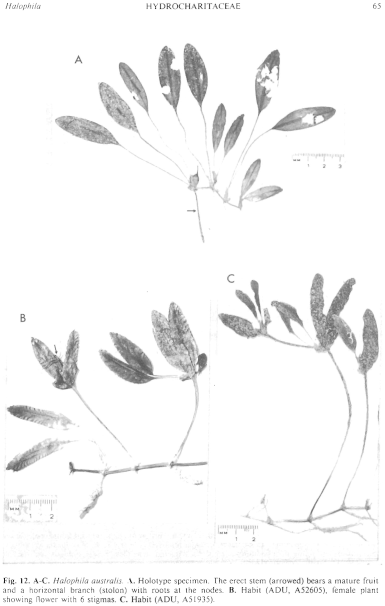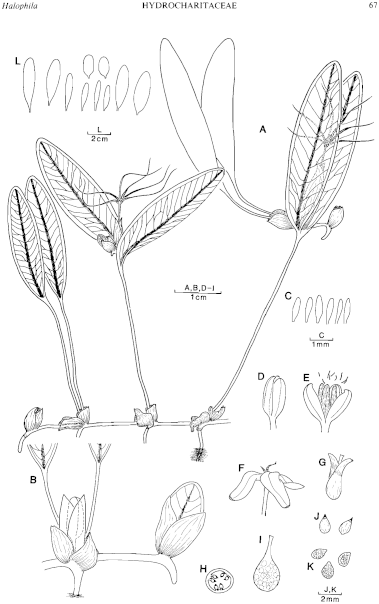|
|
|
|
|
|||||||||||
|
Electronic Flora of South Australia Species Fact Sheet
Phylum Magnoliophyta – Subphylum Seagrasses – Class Liliopsida – Subclass Alismatidae – Order Hydrocharitales – Family Hydrocharitaceae
Synonyms
H. ovalis sensu Aston 1973: 221, fig. 87. Jessop 1978: 86, fig. 53.
H. ovalis (R. Brown) J. D. Hooker, subsp. australis (Doty & Stone) den Hartog 1970: 251. Jacobs & Pickard 1981: 20.
Dioecious; perennial glabrous herb (Pls 15 fig. 3, 16 fig. 4; Figs 12, 13A,B) forming extensive beds. Stolons much-branched, 1–2 mm in diameter, internodes (1–) 2–6 (–8) cm long. Roots one at each node. Scales (3–) 4–5 (–8) mm long, suborbicular, notched at apex but with the central vein extending into a short mucro, distinctly keeled. Leaves in pairs, glabrous, linear-lanceolate to narrow elliptical, (2.5–) 5–6 (–7) cm long, narrowed towards the base, 6–15 mm wide, L/B 3–4 (–6); margin entire; crossveins (10–) 14–16 (–20) pairs arising at angles of 45–60°, some crossveins forked near the base. Petiole terete, up to 10 cm long, usually distinctly longer than the blade. Squamules (Fig. 13C) 2–3, linear to lanceolate, about 1 mm long, in the axil of the petiole. Spathes enclosing either a male or a female flower; spathal bracts (4–) 5–7 (–10) mm long, lanceolate, strongly keeled. Male flower (Fig. 13B, D-F) subsessile within the spathe, borne on a prostrate stolon and frequently at first embedded in sediment, pedicel elongating to about 2 cm carrying the anthers above the sediment at anthesis; tepals 0.5–0.7 mm long, membranous, imbricate, hooded; pollen grains (Fig. 13E) ellipsoid, adhering in short moniliform chains. Female flower (Fig. 13A) solitary, sessile in the spathe, borne on an erect extended lateral shoot 5–15 cm long, which may produce one or more successive, erect, flowering shoots. Scales at first node of the flowering shoot sometimes scarious but more usually green and foliose, subsessile (occasionally shortly petiolate) with the blade (3–) 4–5 cm long. Ovary ovoid, 1–2 mm long, hypanthium 2–5 mm long (sometimes elongating in the fruit), tepals (0.3–) 0.5–1 mm long, styles (Figs 12B, 13A) 6, 6–15 (–20) mm long. Fruit (Figs 12A, 13G–I) ovoid, (7–) 9–11 (–13) mm long, rostrate due to the persistent hypanthium 5–7 mm long. Seeds (Fig. 13J, K) 50–60, subglobose with a reticulate surface, immersed in a gelatinous mucilage. In the mature fruit the seeds are clearly visible through the thin wall.
Type from Queenscliff, Vic. (Lucas, Jan. 1922); holotype in NSW, 3214, and isotypes.
Selected specimens: Point Valliant, Two People Bay, W. Aust., in sheltered pool (Womersley, 30.vii.1979; ADU, A50946). Waterloo Bay, S. Aust., 150 m of end of jetty, 9 m deep (Shepherd, 8.xi.1980; ADU, A51901). East Cove, Pearson I., S. Aust. 20–23 m deep (Shepherd & Turner, 29.iii.1982; ADU, A53022). Farm Beach, Coffin Bay, S. Aust., 5 m deep (Shepherd, 3.xi.1981; ADU, A52605). Quarry Point Reef, Wallaroo, S. Aust., 1–2 m deep (Gill, 21.xii.1980; ADU, A52045). Tiparra reef, Spencer Gulf, S. Aust., 5 m deep (Shepherd, 30.x.1980; ADU, A51825). Brighton, Adelaide, S. Aust. (H.H.D.G. [Griffith], 2.ii.1917; AD, 97507186). Wright I., Encounter Bay, S. Aust., 8–10 m deep (Clarke, 23.xii.1981; ADU, A52823). Encounter Bay, S. Aust., 7 m deep (Clarke, 7.xii.1980; ADU, A51935). Somers, Mornington Pen., Vic., drift ( Wetherill, Feb. 1969; MEL, 589102).
Distribution: Widespread around southern Australia, including Tasmania, extending at least as far north as Dongara, W. Aust. and probably into the central coast of N.S.W.; in both sand and mud from low tide level to 23 m deep, usually in calm water situations.
Taxonomic notes: This description is based on the form most commonly occurring in southern Australia. Some specimens [e.g. from Partney I., Sir Joseph Banks Group, S. Aust., 10–12 m deep (Baldock, 13.xii.1977; ADU, A48932)] have leaves L/B about 2, more or less ovate, and appear closer to H. ovalis, and others [e.g. from Tapley Shoal, Gulf St Vincent, S. Aust., 15 m deep (Shepherd, 2.ii.1969; ADU, A33485)], with linear-lanceolate leaves 1–2 cm long, represent a small-leaved form of the species. Considerable variation of leaf size and shape can also occur on one plant as is shown in the specimen from Pearson I. (Fig. 13L).
Doty & Stone's type description of H. australis refers only to vegetative characters although the holotype bears a mature fruit which is mentioned in their caption of the accompanying photograph. It is apparent on examining the holotype (Fig. 12A) that this specimen is part of an erect extended lateral branch, similar to that shown in Fig. 12C, but which has become detached from the prostrate stolon. After flowering, the branch has continued growth, as is typical for this species, producing a horizontal branch with roots at the nodes. The collection of isotype specimens, also in NSW, contains a number of similar erect shoots, each with a mature fruit. In some fruits, seeds are obvious through the thin wall.
References:
ASTON, H. (1973). Aquatic plants of Australia. (Melbourne University Press: Melbourne.)
DEN HARTOG, C. (1970). The seagrasses of the World. Verh. k. ned. Akad. Wet. Afd. Natuurk., ser. 2, 59(1), 1–275 (-1–31 Plates).
DOTY, M.S. & STONE, B.C. (1966). Two new species of Halophila (Hydrocharitaceae). Brittonia 18, 303–306.
JACOBS, S.W.L. & PICKARD, L. (1981). Plants of New South Wales. A census of the Cycads, Conifers and Angiosperms. (National Herbarium of New South Wales: Sydney.)
JESSOP, J.P. (1978). J.M. Black's Flora of South Australia. 3rd edn. Part I. (Govt. Printer: Adelaide.)
The Marine Benthic Flora of Southern Australia Part I complete list of references.
Publication:
Womersley, H.B.S. (31 May, 1984)
The Marine Benthic Flora of Southern Australia
Part I
©Board of the Botanic Gardens and State Herbarium, Government of South Australia
Illustrations in Womersley Part I, 1984: PLATES 15 fig. 3, 16 fig. 4; FIGS 12, 13.

Plate 15 enlarge
PLATE 15 Fig. 1. Polyphysa peniculus. Coobowie, S. Aust., upper sublittoral in lagoon, Feb. 1964;
Fig. 2. Avicennia marina. Northern Spencer Gulf, S. Aust., upper eulittoral;
Fig. 3. Halophila australis. Off Seacliff, Adelaide, S. Aust., 7-8 m deep. (Photo by S.A. Shepherd.)
Fig. 4. Posidonia australis. Proper Bay, Port Lincoln, S. Aust., 4 m deep. (Photo by S.A. Shepherd.)

Figure 12 enlarge
Fig. 12. A–C. Halophila australis. A. Holotype specimen. The erect stem (arrowed) bears a mature fruit and a horizontal branch (stolon) with roots at the nodes. B. Habit (ADU, A52605), female plant showing flower with 6 stigmas. C. Habit (ADU, A51935).

Figure 13 enlarge
Fig. 13. Halophila australis. A. Habit of female plant. B. Portion of plant, showing young male flower within a spathe. C. Squamules. D. Young male flower removed from spathe. E. Male flower at anthesis, releasing pollen grains in moniliform chains. F. Withered male flower after anthesis with anther remnants. G. Spathe enclosing young fruit, with hypanthium projecting. H. Cross section of young fruit showing arrangement of the seeds. I. Mature fruit, with seeds visible through the thin wall. J. Seeds enclosed in testa. K. Seeds with testa removed. L. Variation in leaf shape on one plant. (A from ADU, A52605. B,D–F from ADU, A51901. C from ADU, A52823. G,H from ADU, A51825. I–K from ADU, A52045. L from ADU, A53022.)

|
Email Contact: State Herbarium of South Australia |

|